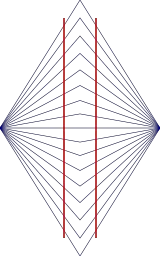Difference between revisions of "Wundt illusion" - New World Encyclopedia
({{Contracted}}) |
|||
| Line 3: | Line 3: | ||
[[Category:Psychology]] | [[Category:Psychology]] | ||
| + | |||
| + | |||
| + | The '''Wundt illusion''' is an [[optical illusion]] where straight lines appear to be curved. The [[Hering illusion]] produces a similar, but inverted effect, and both the Wundt and Hering illusions are similar in nature to the [[Orbison illusion]]. | ||
| + | |||
| + | ==Discovery== | ||
| + | The Wundt illusion is named for German psychologist [[Wilhelm Wundt]] (1832-1920), who discovered the illusion in the 19th century. Wundt is often referred to as the "father of experimental psychology", and is responsible for discovering a number of perceptual illusions. Wundt also discovered one of the most simple line illusions, called the "horizontal-vertical illusion", where a vertical line appears much longer than a horizontal line. | ||
[[Image:Wundt illusion.svg|thumb|right|160px|'''Wundt illusion''']] | [[Image:Wundt illusion.svg|thumb|right|160px|'''Wundt illusion''']] | ||
| + | ==Description== | ||
| + | When looking at the Wundt illusion, one sees a set of vertical red lines over a figure of blue lines that radiate out from two points to the left and right of the set of red lines, meeting in the middle and creating a diamond-like shape. When observing the two red lines, they appear to bow inwards. In reality, they are perfectly straight and parallel. | ||
| + | |||
| + | ==Explanation== | ||
| + | The distorted appearance of the two parallel red lines is created by the angled lines in the background. The exact mechanism by which we perceive the illusion is not fully understood by scientists, but it may have to do with the way the brain and visual system perceive the angles that surround the two red lines. | ||
| + | |||
| + | ==Application== | ||
| + | Like other visual and perceptual illusions, the Wundt illusion helps scientists to study the way images are perceived and interpreted by the visual system. | ||
| + | |||
| + | ==References== | ||
| + | *Pohl, Rudiger. ''Cognitive Illusions: A Handbook on Fallacies and Biases in Thinking, Judgment and Memory'' January 2005. Psychology Press. ISBN 1841693510 | ||
| + | *Rieber, Robert W. ''Wilhelm Wundt in History: The Making of a Scientific Psychology'' November 2001. Springer. ISBN 030646599X | ||
| + | *Wade, N.J. ''Perception and Illusion: Historical Perspectives'' December 2004. Springer. ISBN 0387227229 | ||
| − | |||
| − | |||
| − | |||
{{Credits|Wundt_illusion|115471419|}} | {{Credits|Wundt_illusion|115471419|}} | ||
Revision as of 13:35, 31 October 2007
The Wundt illusion is an optical illusion where straight lines appear to be curved. The Hering illusion produces a similar, but inverted effect, and both the Wundt and Hering illusions are similar in nature to the Orbison illusion.
Discovery
The Wundt illusion is named for German psychologist Wilhelm Wundt (1832-1920), who discovered the illusion in the 19th century. Wundt is often referred to as the "father of experimental psychology", and is responsible for discovering a number of perceptual illusions. Wundt also discovered one of the most simple line illusions, called the "horizontal-vertical illusion", where a vertical line appears much longer than a horizontal line.
Description
When looking at the Wundt illusion, one sees a set of vertical red lines over a figure of blue lines that radiate out from two points to the left and right of the set of red lines, meeting in the middle and creating a diamond-like shape. When observing the two red lines, they appear to bow inwards. In reality, they are perfectly straight and parallel.
Explanation
The distorted appearance of the two parallel red lines is created by the angled lines in the background. The exact mechanism by which we perceive the illusion is not fully understood by scientists, but it may have to do with the way the brain and visual system perceive the angles that surround the two red lines.
Application
Like other visual and perceptual illusions, the Wundt illusion helps scientists to study the way images are perceived and interpreted by the visual system.
ReferencesISBN links support NWE through referral fees
- Pohl, Rudiger. Cognitive Illusions: A Handbook on Fallacies and Biases in Thinking, Judgment and Memory January 2005. Psychology Press. ISBN 1841693510
- Rieber, Robert W. Wilhelm Wundt in History: The Making of a Scientific Psychology November 2001. Springer. ISBN 030646599X
- Wade, N.J. Perception and Illusion: Historical Perspectives December 2004. Springer. ISBN 0387227229
Credits
New World Encyclopedia writers and editors rewrote and completed the Wikipedia article in accordance with New World Encyclopedia standards. This article abides by terms of the Creative Commons CC-by-sa 3.0 License (CC-by-sa), which may be used and disseminated with proper attribution. Credit is due under the terms of this license that can reference both the New World Encyclopedia contributors and the selfless volunteer contributors of the Wikimedia Foundation. To cite this article click here for a list of acceptable citing formats.The history of earlier contributions by wikipedians is accessible to researchers here:
The history of this article since it was imported to New World Encyclopedia:
Note: Some restrictions may apply to use of individual images which are separately licensed.
